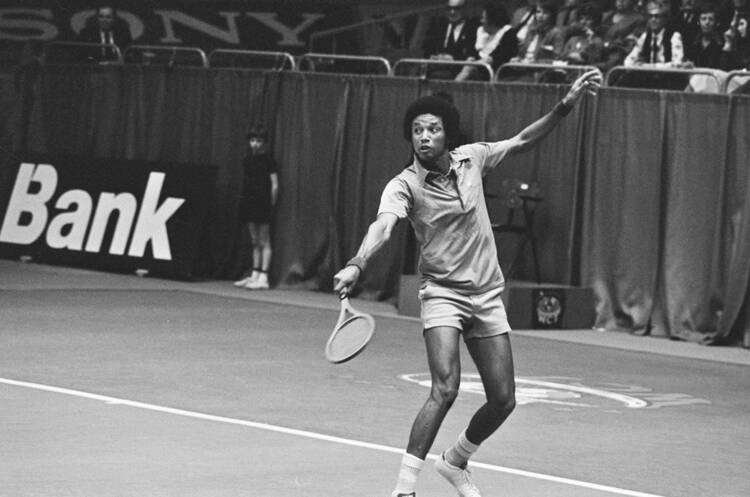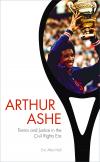Superman with a Racket
The greatest athletes transcend mere games. They soar above competition, tower over leagues, fuel economies and even change societies. They always represent more; on the field, in the ring and off the court. The truly great ones even continue to touch lives when they’re not competing. Burning with passion, a love of the game so fierce and severe they are forced to do it their way, they march through thorns, briars and fire, if need be.
And so it was with Arthur Ashe Jr.
Arthur Ashe Sr. instilled in his son that “a seeing eye and listening ear, silent tongue and faithful heart, time and patience accomplish everything.” It grew to a powerful formula—composed, never bitter, and sophisticated and practical—which molded a star and champion, and made a man strong enough to battle racism (and face down apartheid) in a time of violent racial turmoil. Which is why today, Ashe’s story is relevant as ever.
And once again, too, America's best athlete is a black tennis player.
Ashe was a son of Jim Crow, raised on dangerously neglected playgrounds, sipping from colored-only fountains. After his mother died when he was six years old, he was raised by a too-disciplined father, who always had a job, kept him off the street and encouraged him to read.
A great talent with a greater work ethic, he attended UCLA and joined the military to be like his hero, Jackie Robinson. And though an excellent baseball player—blessed with whipping wrists and wicked quickness—he quit to be more like his hero.
In no time, Ashe combined overpowering serves with impeccable demeanor, and became a trailblazer, integrating tournament; then he donned Clark Kent glasses and turned into Superman, winning the National Junior Indoor Championship (1960), the U.S. Amateur Championship and a collegiate National Championship. The first black man on America’s Davis Cup squad (1963), he broke U.S. Championship attendance records (1965) and won the U.S. Open (1968) and Australian Open (1970).
Just the third tennis star to mint a million, in one year he traveled 165,000 miles (450 per day!) while playing on five continents. Meanwhile, networks tripled coverage. CBS famously paid more for tennis matches than for NFL games.
Today, he is a Civil Rights sporting icon; alongside Jack Johnson, Jesse Owens, Joe Louis, Althea Gibson, Jackie Robinson, Bill Russell, Jim Brown and Muhammad Ali.
The best sports writing, too, transcends games and even sports itself. But it also does not fail to touch the bases. This book, unfortunately, sometimes shows why. Whileauthor Eric Allen Hall is an excellent researcher (e.g.; 44 included pages of notes 'on notes') too often, the research swells to the point that Ashe the man and even tennis itself drowns in the detail. Ashe's time in South Africa is an especially stormy sea of citations, annotations and long descriptive strings of references and titles.The result is clean and accurate, but stiff; more box-score than fresh-rendered concerto. It can be a harsh wash; bleaching color, leaching flavor and rinsing out the tension and drama. Even after 300 pages, I can’t picture Ashe playing; the elegance, grace, skill and timing? The portrait just isn’t there. Actual images lack, too; only a dozen, too-thinly spread. (A good rule of thumb for sports books, perhaps would be research in thirds: literature, photos and game action). So this stands foremost as a research piece; no less worthy though, because Ashe’s story is extraordinary.
“Anyone who wouldn’t watch (him) play wouldn’t watch Picasso paint, Hemingway write, a diamond cut, Astaire dance, or Gielgud act. Nobody calls him 'Art' but he is,” sportswriter Jim Murray once wrote.
On-court, Ashe rejected stereotypes like weak serves, smashing illusions of “blacks as fast, muscled brutes who fell victim to the intelligence, wit and strategy of whites,” as Hall writes.
But unique among Civil Rights figures, Ashe also suffered Blackignorance. While early boxers and baseball players enjoyed internal community support—tennis was mostly “white clothes and white balls, hit before white audiences,” Hall notes. Ashe was mocked in ways only young Tiger Woods (and black astronauts, mathematicians and Catholics) would understand. Both sides crushed him. Prominent critics included Harlem’s Stokely Carmichael, Watts’ Ron Karenga, the NAACP and the Chicago Defender. Even within the game, they mocked him: “a prim snob … aloof, detached, unresponsive … so dignified, painful to watch.”
“I grew up aware I was Negro, a coon, a pickaninniny, nigger, ace and spade,” Ashe said. He could not hail cabs, play in parks, take in movies, or walk alone downtown. And even when admitted to elite clubs, patrons mistook him for ‘the help’ and ordered drinks. And still Billie Jean King ignorantly spewed: “Christ, I’m blacker than he is.” No you're not. And I wonder how many people spat on you, as a child?
Ashe just shrugged: “Those were the frenetic, psychedelic, schizophrenic '6os. A moderate progressive's hero could be the reactionary's nigger and the revolutionary's Uncle Tom.”
Meanwhile, he deftly counterbalanced raw black radicalism (“Stokely shouts black is beautiful. But that doesn’t mean white isn’t”). He also refused to blanket-tarnish whites (“research the man first”). He rejected separatism, remaining ardently integrationist (“there’s nothing constructive about quarantined isolation”). And he even opposed Affirmative Action and Proposition 48 (as “sub-standard status quos”). He opposed draft-dodging (“if there's a job to do in Vietnam, the sooner it's over the better”). But he also rejected violence: “I’m with Thoreau, Gandhi and King. It achieves nothing but the destruction of the soul and corruption of the state.”
His thoughtful eloquence touched old Europe’s aristocratic quarters and surfaced in New York Times and Washington Post editorials (his rare sporting peer: Kareem Abdul Jabbar). He was also arrested protesting.
Unfortunately, “distractions” crippled his performance. In Apartheid South Africa, for instance, battling Colonial-era racism and multi-national industries (diamonds, gold, cobalt and uranium!) left little juice for blistering serves. Once there, he mostly lost – on-the court and off. Still, he made his mark. And Nelson Mandela—freshly freed from prison after 30 years of captivity—first asked to see him.
And Ashe always kept cool. Once, television commentators overheard Ilie Nastase call him “a bloody nigger” on-court. Ashe didn’t flinch, or play the victim: “I know Ilie personally. He goes off half-cocked. He made a mistake, certainly. But he is no racist.”
Most telling: Summer of 1968. Burning, riots, looting, violence and destruction follow King’s assassination. Ashe disappears, declining marches and speeches. He later resurfaces on a Milwaukee playground, leading free tennis clinics for black and white children, together.
It was the ethos all great athletes share, in a nutshell: you can do as much good simply by sharing your love, as you can at a million protests and rallies … so long as you don’t let someone else tell you how to do the right thing.










